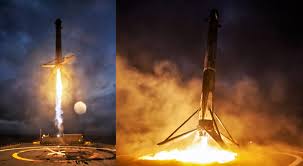Today, SpaceX has marked a ground-breaking day as the company’s Falcon Heavy megarocket has lofted two dozen satellites into orbit successfully. The rocket take off on June 25 (0630 GMT) from the Launch Pad 39A which is located at Kennedy Space Center (KSC). The launch took place at 2:30 am, three hours into the launch window, that marks the Falcon Heavy’s first flight at night as well as third launch all inclusive.
The launch was also a part of the U.S. Air Force’s Space Test Program as well as carried payloads for universities, NASA, the National Oceanic and Atmospheric Administration (NOAA), also comprising the nonprofit organization The Planetary Society.
The Falcon Heavy is basically a partly reusable heavy-lift launch vehicle that is specifically designed as well as manufactured by SpaceX. It is resultant from the Falcon 9 vehicle and comprises of a strengthened Falcon 9 first stage as the centre core along with the two additional first stages as strap-on boosters.
The remarks of today’s mission are that it supports the U.S. Air Force National Security Space Launch (formerly EELV) certification procedure for the Falcon Heavy. The secondary payloads comprises of orbiters: LightSail, GPIM, OTB (hosting the Deep Space Atomic Clock), 6 COSMIC-2, Oculus-ASR, Prox-1, as well as ISAT.
The Falcon Heavy has the maximum number of payload capacity of any operational launch vehicle at present, and is also the second-highest capacity of any rocket ever to reach orbit.
For those who don’t know much about SpaceX, so, Space Exploration Technologies Corp., undertaking business as SpaceX. It is a private service provider company of American aerospace manufacturer and space transportation which headquarters are in Hawthorne, California. It was founded by entrepreneur Elon Musk in 2002 with the objective of decreasing space transportation expenses and facilitating the establishment of Mars. Since then, SpaceX has established the Falcon launch vehicle family as well as the Dragon spacecraft family, which both presently distribute payloads into Earth orbit.
Today’s launch marked the first Falcon Heavy ever to fly reused boosters; as part of the first commercial Falcon Heavy launch, the two side boosters had previously flown, which then lofted a communications satellite named Arabsat-6A, in the month of April. The core booster of that rocket landed successfully as well, but then it was lost on the way back to shore when the boat come across choppy seas.
Earlier, the company on Twitter announced that it would be aiming 2:30 am EDT (0630 GMT) on June 25, three hours into the launch window for the mission. On the other hand, the statement didn’t provide any further details about why the decision was made.
A company spokesperson wrote, “Team completed additional ground system checkouts. Vehicle and payload continue to look good.”
The following SpaceX launch is planned for July 21, when a Falcon 9 is going to carry a cargo shipment to the International Space Station. Though the company has not yet announced the specific date for its next Falcon Heavy flight but it is expected to be announced soon.








